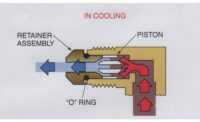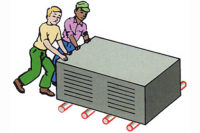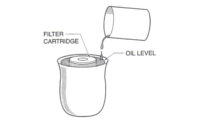Bob receives a call at about 9 a.m. that a restaurant system is not cooling the dining room where a men's breakfast is being held. This is a new customer for his company.
When Bob arrives, he goes to the restaurant owner to talk to him and see what he can find out. The owner tells Bob that a banquet had been held in that same dining room last night and that the system had not cooled the room then.
When Bob goes to the roof, the outside air is still cool from the night before. It had gone down to 55 degrees F. The system is a split system with the evaporator and air-handling unit in a downstairs closet. Bob could hear the unit's fans and compressors running. The system has two compressors of 7-1/2 tons each. When he gets close to the unit, he notices that the suction line is frozen solid. The compressors are solid sheets of ice as well.
Bob goes down to the space temperature thermostat and turns the unit to "fan on" and turns the system to off to stop the compressors. The temperature setting for the thermostat is 55 degrees F. He is pretty sure that the problem was trying to operate the unit below the design parameters but he wants to be sure. He is sure that the system froze because of a combination of the thermostat being set for a temperature that was too low and low outdoor ambient temperature. The problem is what could he do about it to prevent it from happening again.
Bob explains to the manager that it would take about an hour to defrost the coils and that he would go to another job that was close by during the defrost time. The manager thanks Bob for keeping him informed. He tells Bob that he had used other service companies before and that the technicians would just leave and he was disturbed that they would leave without an explanation.
When Bob returns, the system is thawed and ready to run. Since this is his first trip to this customer site, he decides to look the unit over carefully. The system is about two years old and looks to be in good shape. He checks the filters and they are clean. The owner had said that he changed them on a regular basis. Bob lubricates the evaporator fan motor and is then ready to start the system. He is concerned that the system may have a low charge, so he decides to check it out. This system has two coils and two thermostatic expansion valves as metering devices.
Bob starts the system and goes to the roof to see how it is reacting. When he gets to the roof, the suction line is cold on both compressors. The system seems to be running normally for a morning that is 70 degrees F. He is standing there thinking when Btu Buddy says, "What is the problem, Bob?"
Bob says, "This system froze solid last night because the thermostat was turned down to 55 degrees and the outdoor temperature was too cool to operate the system, even though it has thermostatic expansion valves. I am not sure where to start."

POSSIBLE SOLUTIONS
Btu Buddy then suggests, "You have three possible solutions that could be used. I think all three would be good in this case:1. Put a lock box on the thermostat and tell the manager to only give one informed person the key. The turned down thermostat problem often happens at night when a night shift person doesn't realize what the consequences are. Many people think that, if you turn the thermostat to a lower position, the unit cools faster. They think the thermostat is like an accelerator on a car. They don't know that it is like a light switch.
2. Install a "low-ambient" control to control the condenser fan speed or cycle the condenser fans to maintain a minimum head pressure (Figure 1).
3. Install a freeze control on the suction lines to shut off the compressors when a freeze condition is sensed (Figure 2).

"I would suggest that you contact the manufacturer for a low-ambient kit for this particular unit. It is probably available. The freeze control is an extra for the best protection."
Bob goes to the owner and explains what was happening. The owner asks Bob for a quote to make the control system functional under these conditions. Bob goes to his truck and figures it all out and gives him a quote. The owner then gives Bob permission to proceed.
Bob is able to get a low-ambient control kit for the unit that straps on the liquid line and measures the temperature and cycles the condenser fan at the appropriate time. This is much better than using a low-ambient kit that uses pressure as the sensor. He would not have to create a pressure source on the system. He also purchases a thermostat cover that has a lock. The cover has good ventilation so the thermostat would have good airflow over the sensor. He then purchases two freeze controls, one for each compressor.

The owner says, "Thanks for giving my system a good check out. It is nice to know that it is in the hands of a professional."
As they are riding away from the job, Btu Buddy says, "You did a good job of taking care of that customer. I think that he will request you for the next job."
Bob then says, "It really feels good to leave a job and know that you got the job done right and that the customer is satisfied."
Bill Johnson has been active in the HVACR industry since the 1950s. He graduated in gas fuel technology and refrigeration from the Southern Technical Institute, a branch of Georgia Tech (now known as Southern Polytechnic Institute). He taught HVAC classes at Coosa Valley Vocational & Technical Institute for four years. He moved on to become service manager for Layne Trane, Charlotte, N.C. He taught for 15 years at Central Piedmont Community College, part of this time as program director. He had his own business for five years doing installation and service work. Now retired, he is the author of Practical Heating Technology and Practical Cooling Technology, and continues as a co-author of Refrigeration & Air Conditioning Technology, 5th Edition, all published by Thomson Delmar Learning. For more information, he can be reached at 704-553-0087, 704-643-3928 (fax), or billj@carolina.rr.com.
Publication date: 05/15/2006







